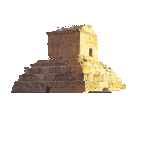|
Achaemenid Art
|
Glazed
brick relief panel
Achaemenid, late 6th century BC
From Susa, south-west Iran
From the palace of Darius I, ruler of the largest empire in antiquity
This panel is made of polychrome glazed bricks which were found by
French excavators scattered in a courtyard of the palace
built by the Persian king Darius I (522-486 BC). At least 18 figures have
been restored and this example is on permanent loan to The British Museum
from the Musée du Louvre, Paris. It was part of a larger frieze depicting
rows of guards, perhaps the 'immortals' who made up the king's personal
bodyguard. The arrangement of the figures may have been similar to the
rows of sculptured guards carved in relief at
Persepolis. According to a
foundation inscription at Susa, the craftsmen who made the brick panels
came from Babylonia where there had been a tradition of this sort of
architectural decoration.
Linked to the city of Sardis in western Anatolia by a 'royal road', Susa
was the most important administrative centre of the Achaemenid Persian
empire and the court probably spent at least part of each year there.
Darius undertook much building at the site. Amongst his most impressive
projects was the Apadana or audience hall and an adjoining palace where
this panel was discovered.
Height: 199 cm
Width: 27.5 cm
Back to
the top
|
Back |




